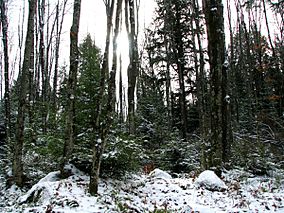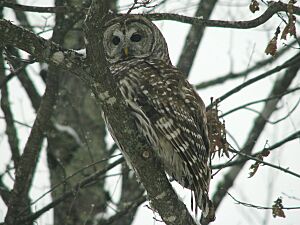Chequamegon–Nicolet National Forest facts for kids
Quick facts for kids Chequamegon–Nicolet National Forest |
|
|---|---|
|
IUCN Category VI (Managed Resource Protected Area)
|
|

The Nicolet National Forest in November
|
|
| Location | Wisconsin, United States |
| Area | 1,534,225 acres (6,208.79 km2) |
| Established | 1933 |
| Governing body | U.S. Forest Service |
| Website | Chequamegon–Nicolet National Forest |
The Chequamegon–Nicolet National Forest (say "She-WAH-meh-gon NIH-koh-lay") is a huge forest in northern Wisconsin, United States. It covers about 1.5 million acres, which is like 2,397 square miles! This makes it one of the biggest national forests in the country.
Even though it has one name, it's actually two separate national forests. They are the Chequamegon National Forest and the Nicolet National Forest. They were created in 1933 and have been managed as one big area since 1993.
A long time ago, in the early 1900s, a lot of trees were cut down here. So, not many very old trees are left. But many new trees were planted in the 1930s by a group called the Civilian Conservation Corps. The forest is now full of trees and plants that are typical of the "North Woods" area around the Great Lakes.
Contents
Exploring the Chequamegon Forest
The Chequamegon National Forest is in the north-central part of Wisconsin. It covers about 865,825 acres. Its main office is in Park Falls. You can also find smaller ranger offices in towns like Glidden, Hayward, and Medford.
This part of the forest has two special "wilderness areas." These are places where nature is left wild and untouched by humans. They are called the Porcupine Lake Wilderness and the Rainbow Lake Wilderness.
Exploring the Nicolet Forest
The Nicolet National Forest is in northeastern Wisconsin. It's about 664,822 acres in size. The main office for this forest is in Rhinelander. There are also ranger offices in places like Eagle River and Lakewood.
The Nicolet Forest also has three wilderness areas. They are the Blackjack Springs Wilderness, the Headwaters Wilderness, and the Whisker Lake Wilderness. These are great spots to see nature just as it is.
Plants and Animals

The Chequamegon–Nicolet National Forest is home to many different kinds of plants and animals. You can find all sorts of places here, like quiet forests, wet bogs, rivers, and many beautiful lakes formed by glaciers.
Trees and Plants
Many types of trees grow here. You'll see sugar maples, red maples, and different kinds of oaks. There are also aspens, beech trees, and basswoods. You'll find many birch trees too, like paper birch and yellow birch.
Lots of pine trees grow here, including red pine and white pine. You might also spot white spruce and balsam fir. The Eastern hemlock tree also grows here, which is special because this is as far west as it usually grows.
In wet areas, you'll find tamarack and black spruce bogs. There are also cedar swamps. The forest floor is covered with blueberries, raspberries, blackberries, and cranberries. You'll also see ferns, mosses, and many kinds of wildflowers.
Wildlife
This forest is full of amazing animals! You'll see many White-tailed deer. Sometimes, Black bears, foxes, and raccoons roam around. Smaller animals like rabbits, beavers, river otters, and squirrels are common.
Some animals that were once gone from the area have been brought back. These include Elk and wolves. You might even spot a moose or a pine marten if you're lucky!
The forest is a paradise for bird watchers. You can see colorful birds like northern cardinals and blue jays. There are also owls, ducks, and the famous common loon. Look up, and you might spot a majestic bald eagle flying overhead. Many types of thrushes, sparrows, and warblers also live here.
Fish
The lakes and streams are perfect for fishing. You can catch Brook trout, rainbow trout, and brown trout in the clear streams. The lakes are known for Walleye, smallmouth and largemouth bass, crappie, and northern pike. Wisconsin's state fish, the huge muskellunge, has even been caught here!
Fun Things to Do
The Chequamegon–Nicolet National Forest is a popular place for outdoor adventures. People love to come here for:
- Camping: Spend a night under the stars.
- Hiking: Explore the many trails and see beautiful scenery.
- Fishing: Try to catch some of the famous fish in the lakes and rivers.
- Cross-country skiing: Enjoy the quiet beauty of the forest in winter.
- Snowmobiling: Ride through the snowy trails for an exciting winter sport.
Thousands of visitors come to this forest every year to enjoy its beauty, learn about its history, and have fun outdoors.
Gallery
-
Ranger station in Washburn









